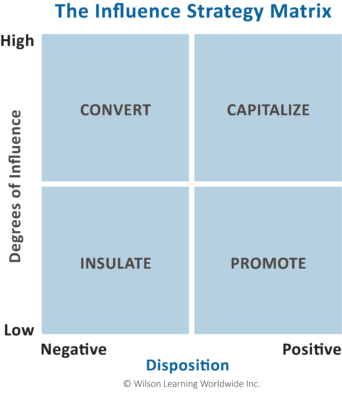The Stakeholders
Different stakeholders often have widely divergent views of what a solution should do and the criteria for success.
While companies give all competing vendors a list of “official” criteria, smart salespeople dig deeper to identify each stakeholder’s specific issues and concerns. For example, people in IT focus on technological performance and installation, finance leaders are concerned about ROI, and end users want ease of use with minimal disruption to work during the transition.
Beyond having different opinions about buying criteria, stakeholders have various levels of interest and influence in the decision. Strategically steering the decision process to a win requires salespeople to answer three critical questions:
- Who has a stake in the decision and could influence the outcome? (The questions above help answer this one.)
- Who has the most influence over the final decision-maker(s)?
- How does each person view me and my competitors?
Levels of Influence
Stakeholders may have formal or informal influence on the decision.
Formal influence may seem more obvious—like who has the power of the purse. But salespeople beware! While formal levels of influence may seem obvious—the C-suite has the power!—the reality can be very different. For example, a CIO may be the highest ranking stakeholder on a buying committee, but if she isn’t interested in the buying decision, she won’t exert much influence. Instead, a well-regarded director who views the purchase as critical to his success may have far more influence over the ultimate choice.
That brings us to informal influence, which isn’t about hierarchy or position power. Every organization has those they rely on for information and results. These people tend to be admired and respected, with strong expertise, a great track record, and a broad base of support. Salespeople need to determine who holds this informal influence—and then engage them to build their own base of support.
Perspectives on Me and My Competitors
Salespeople know they have to understand the decision process and stakeholders’ perspectives about buying criteria, but do they always know each stakeholders’ thoughts about them—and their competitors?
High-influence stakeholders who advocate for a competitor can be a serious barrier. Every experienced salesperson has a story about a stakeholder who had a prior relationship with his or her competitor—or even one who had a prior bad experience with the salesperson’s own company. Plus, personal and political alliances can derail an on-target solution and a compelling proposal.
Knowing who is involved, their interests, level of influence, and disposition toward competing vendors helps salespeople craft influence strategies that lead to a win.
The Influence Strategy Matrix

The Influence Strategy Matrix helps salespeople leverage their knowledge of the decision process and players to execute a plan to “influence the influencers.”
The influence strategy for each stakeholder depends on their level of influence and disposition toward the salesperson and his or her company—whether they view them positively or have reservations.
“They Like Me!”
Salespeople should strategically leverage those who are positively disposed toward
them, their company, and their solution.
Salespeople should Capitalize on the influence of stakeholders with high influence as well as those who prefer the salesperson and their company. When a stakeholder is positively disposed toward them but less influential, the salesperson can Promote their level of influence by inviting them to meetings and asking them to share their expertise and opinions in front of others.
“They Don’t Like Me”
In the best of all worlds, every stakeholder would prefer the salesperson’s company and proposal but, given the complex nature of B2B sales, that rarely happens. Salespeople need to have influence strategies for those who:
- Don’t know them and their company
- Don’t yet see the value they offer
- Prefer a competitor
When a stakeholder has a negative disposition toward the selling organization but has high influence, it’s worth the time and effort required to Convert the stakeholder by improving their opinion of the salesperson’s ability to deliver value. When a stakeholder has low influence and is not an advocate for the salesperson’s proposal, the objective becomes Isolating them from other decision-makers to limit the damage they can do to the sales campaign.
Conclusion
A successful influence strategy depends on knowing who is involved, what issues each cares about, their level of influence, and their perspectives about the salesperson’s company and their competitors. Armed with this information, a salesperson is ready to deploy the influence strategies needed to win.
1 Google/Millward Brown Digital, B2B Path to Purchase Study, 2014.
2 https://www.gartner.com/en/sales/insights/b2b-buying-journey
3 2020 B2B Buyers Survey Report, DemandGen


